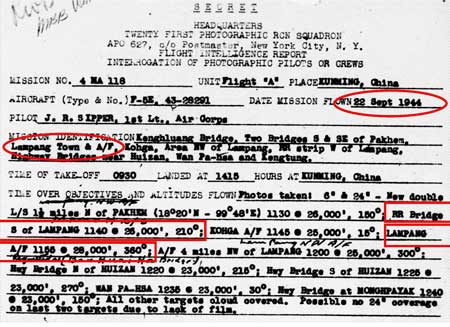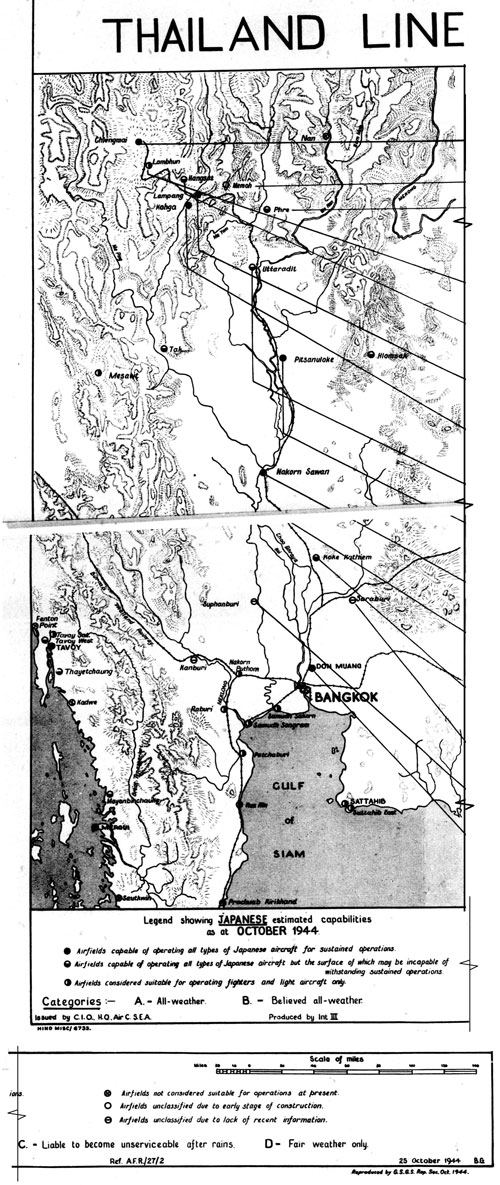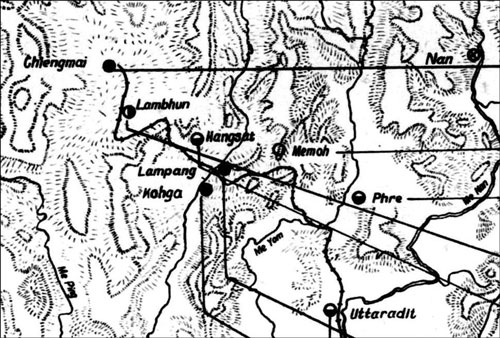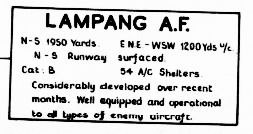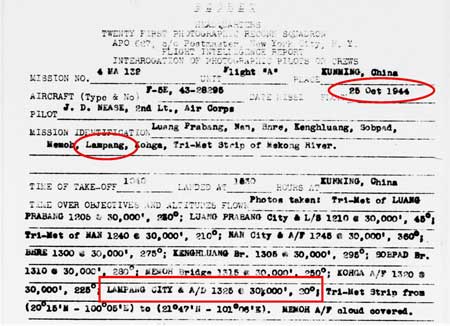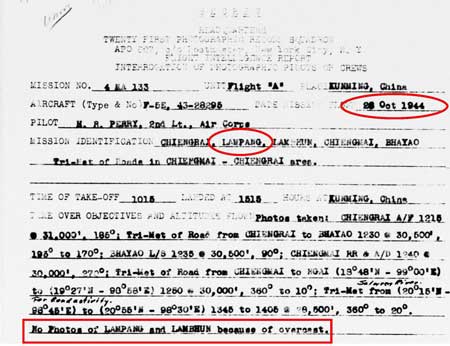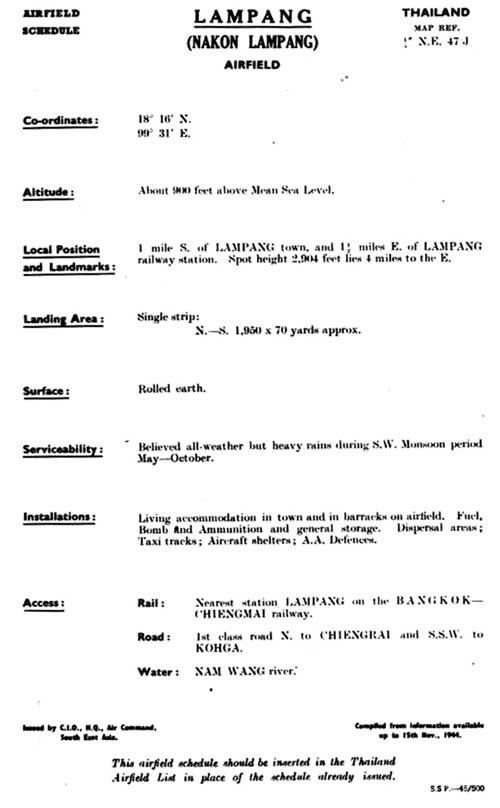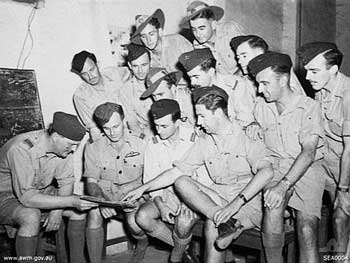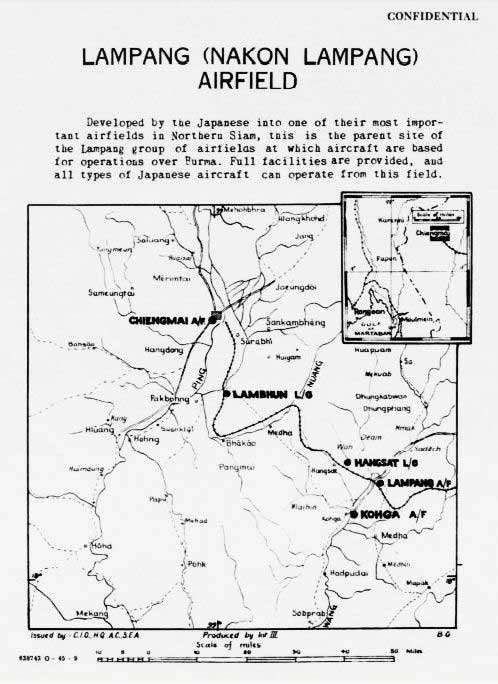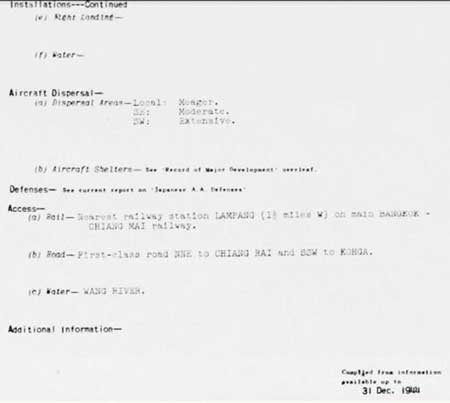| N18°17 E99°28 |
Lampang Airport (Th: ลำปาง ลำพูน / Jp: ランパーン 滑走路 ) page 4b of 7 |
Route 0001 Station 00c |
| Text | Notes |
|
July 1944 Per Japanese Monograph No 177, "Outline of Army Disposition in July 1944": 161st Independent Infantry Battalion [was] stationed at Lampang in Northern Thailand and responsible for security in the area. . . .[35]
TRANSCRIPT: Lampang Airfield: Activity: No aircraft observed. (17/8/44) Development: Resurfacing and rolling at the north end of the runway have been carried out since the middle of May. New tracks have been cleared and partly rolled to the east of the runway to form loops linking the north end of the site with the centre and southern end. Several lengths of taxi tracks have been re-rolled in the southeast dispersals. (17/8/44)
TRANSCRIPT: Lampang Airfield Development: Post-monsoon airfield reclamation work in progress. E-W runway being rolled. (26/SEPT/44) Allied intelligence views of Japanese strategy had been presented in April 1944 and, though written before the IJA failed attack at Kohima and Imphal in India, it had been prescient and the term, "main Thailand line of airfields", had been introduced to describe a potential IJA line of support for Burma and defense from Allied air attacks. Clarification in the form of a map entitled "Thailand Line of Airfields" only appeared six months later in the October Airfield Report:[37a]
To download a higher resolution file of the complete map, click here. A closer view of northwest Thailand in that map:[37c]
Transcript: LAMPANG AF N-S 1950 yards Considerably developed over recent month. Well equipped and operational to all types of enemy aircraft Note that "Shelters" had not increased from the 54 noted in 21 April 1944.
The USAAF Chronology showed no activity around Lampang on this date.
On this date, Allied intelligence generated a detailed map sketch of Lampang Airfield, which it published in the January 1945 issue of Airfield Reports.[38b] From the USAAF Chronology: CBI - THEATER OF OPERATIONS - CHINA (14AF): . . . 70+ P-40s, P-51s and P-38s over S China and N Indochina on armed reconnaissance hit targets of opportunity at several locations, concentrating on Lampang, Thailand, and the Changsha, Lingling, and Hengyang, China areas.[39] The USAAF strafed and damaged a locomotive between Chiang Mai and Ban Dara; then strafed the Lampang Airfield.[39å] Five Ki-27s from RTAF Squadron 16 at Lampang engaged them. In one dogfight, RTAF CWO Chuladit Detkanchorn[39ж] was credited with the shootdown of a P-51. Two P-51s were damaged. All five Thai aircraft were shot down; four of the pilots were wounded, and one, CWO Nat Sunthorn, was killed. [39a] A USAAF fighter aircraft (the P-51 reported shot down above) was apparently downed in a dogfight near Lampang with pilot, Henry Minco, killed.[39a1]
The American fighters flew ten more missions over northern Thailand during the month [November 1944], and on five of these they strafed the airfields at Chiang Mai, Lampang, and Chiang Rai.[39b]
The RTAF reported downing four enemy fighter aircraft this date; one each in: Lampang
TRANSCRIPT: 12 Beau [Beaufighters] attacked enemy communication lines in Chiang Mai-Lampang area . . .
There appears to be an inconsistency here: with a surface of "rolled earth", the serviceability was nonetheless "believed all-weather". Elsewhere "metalled" surfaces generally seemed to have been the only type rated "all-weather".
Information about the photo reads in part: Salbani, Bengal, India. 1944-11-23. Informal group portrait of RAAF members of No. 355 (Liberator) Squadron RAF being briefed by Wing Commander (Wg Cdr) J. Martin DFC, RAF, for a mission against Lampang, railhead for the road running into the Shan States through Chiengmai in Thailand. The above description of the mission is somewhat garbled: Lampang was the target. However, the railhead for the Thai Railway was at Chiang Mai, north of Lampang. Nonetheless, the main road connecting to the Shan States, ie, Kengtung, ran north from Lampang through Mai Sai, not Chiang Mai.
25 November 1944: CBI - THEATER OF OPERATIONS - CHINA (14AF): . . . 75 P-40s, P-51s, and P-38s on armed reconnaissance attack river, road, and rail traffic, troops, buildings, and other targets of opportunity at several Thailand, Burma, S China, and N French Indochina locations, including areas around Bhre [Phrae] and Lampang, Thailand . . . .[42a] TRANSCRIPT, as relevant: THAILAND AREA: 15 Liberators dropped 39 tons bombs over loco [locomotive] sheds --- Chiang Mai-Lampang area causing large fires. Meager and inaccurate light AA [anti-aircraft fire] encountered . . . .
Young summarized: . . . Allied air raids continued into December, with fighters and heavy bombers flying twelve missions, there were no further encounters with the Thai Air Force.[42b҂]
The relevant text above reads: Rail targets at . . . the Chiengmai-Lampang rail sections were attacked by RAF Liberators. . . .
The USAAF chronology recorded no action over Thailand on 07 December 1944.[42b2]
. . . the [IJA] Southern Army received orders from Imperial General Headquarters to reorganize the Thailand Garrison Army into the 39th Army. On the same day, the Thailand Garrison Army was redesignated the 39th Army with no change in mission.[42b3]
26 December 1944: CBI - THEATER OF OPERATIONS - CHINA (14AF): . . . 46 P-51s, P-38s, and P-40s hit railroad targets, shipping, storage and other targets of opportunity at or near Kinkiang, Anking, and Ka-chun, China; Lampang, Thailand . . . .[42c]
TRANSCRIPT: Coordinates --- 18°16N; 99°31E
|
35.^Japanese Monograph No 177, p 15. It is not clear when this assignment in Lampang began: the battalion is listed as early as Nov 1943 as having been part of the 29th Independent Mixed Brigade, within Thailand (p 13) which became part of the Thailand Garrison Army in January 1944 (p 14). 36.^ "Record of Airfield Activity and Development", Airfield Report No. 25,
36a.^ 21PRS Report Mission No. 4 MA 115, 16 Sep 1944
36b.^ 21PRS Report Mission No. 4 MA 118, 22 Sep 1944
37.^ "Record of Airfield Activity and Development", Airfield Report No. 25, Aug 1944, p 8
37a.^ Airfield Report No. 27 (Oct 1944), facing p ii
37b.^ ibid (excerpt)
37c.^ ibid (excerpt).
37c1.^ ibid (excerpt)
37c2.^ Airfield Report No. 27, Oct 1944, p 14
37d.^ 21PRS Report Mission No. 4 MA 132, 25 Oct 1944
37e.^ 21PRS Report Mission No. 4 MA 133, 26 Oct 1944
38a.^ For details, see McKinney. Enquiries are in progress.
38b.^ The map sketch is presented and discussed at considerable length under Jan 1945 (when it was presented) in order to preserve the continuity of comparatively intense activity here. 39.^ USAAF Chrono 1944. 39å.^ J-aircraft notes a single engined aircraft destroyed on the runway 39ж.^ Identified as Kamrob Plengkham in Royal Thai Air Force Museum Paintings which include a rendering of the air battle. 39a.^ Young, ibid, p 205. Both RTAF 1913-1983 (p 330) and RTAF WW2 (p 164) date this encounter as 17 Nov 1944; further, both RTAF histories identify RTAF aircraft as Ki‑61‑1‑Otsus. Assignment by the IJAAF of Ki-61s to the RTAF is not confirmed by any other source. 39a1.^ For details, see Minco. 39b.^ Young, ibid. 40.^ "Record of Airfield Development and Activity", Airfield Report No. 28, Nov 1944, p 8 40a.^ Photographic Interpretation Review No. LB/4, (?: CPIC, SEA, 01 ‑ 15 Dec 1944), unnumbered page 40b.^ RTAF WW2, p 165. If the date were 11 Nov, then the pilot downed at Lampang was Minco. Verification of downed aircraft at the three other locations has not been found in any other source. 41.^ Summary for 14 November 1944: Brief of Principal Air Operations Reported (?: ), unnumbered page (USAF Archive microfilm reel A8202 p0356). 41a.^ Airfield Report No. 28, Nov 1944, unnumbered page (USAF Archive microfilm reel A8055 p1083).
42.^ Photo and text from Salbani, Bengal, India, Australian War Memorial website. "Copyright expired".
42a.^USAAF Chrono 1944.
42α.^ Summary for 27 November 1944: Brief of Principal Air Operations Reported (?:), unnumbered page (USAF Archive microfilm reel A8202 p0339).
42b.^ USAAF Chrono 1944.
42b0.^ Young, ibid, p 205.
42b҂.^ ibid.
42b҂1.^ Summary for 03 December 1944: Brief of Principal Air Operations Reported (?: ), unnumbered page
42b1.^ For details, see Ankrim. 42b2.^ USAAF Chrono 1944.
42b3.^ Japanese Monograph No 177: Thailand Operations Record, p 19.
42c.^> USAAF Chrono 1944.
43.^ Siam (Thailand): List of Airfields and Seaplane Stations (Washington: Office of Assistant Chief of Air Staff, Intelligence, 1945), unnumbered page (USAF Archives microfilm reel A1285 pp1221-1223). Information is dated in pages following as 31 Dec 1944.
44. (deleted). 45. (deleted).
|


